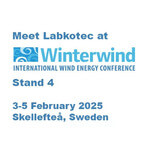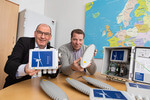05/04/2011
Product Pick of the Week - NASA paints a new scenario for the future of wind energy
This could very well be a true - a scenario of future power collectors according to NASA. A federal fund of $100,000 has been reserved for exploring high-altitude, nano-tube cable roped, air-borne wind farms. The incentive will check all aspects as well as weigh the pros and the cons of a wind farm such as this one.
Mark Moore, aerospace engineer at NASA, outlined this research as a study to look at the practicalities of the idea of air-borne turbines. To know the challenges that will be faced when turbines are working at 30,000 feet above ground level — and what the effect will be on airspace and unmanned aircraft — is what the project is aiming to uncover.
At higher altitudes, wind has more power and velocity and is more consistently predictable. As power generated goes up because of higher wind resistance proportional to the cube of relative velocity, more power can be generated. That works out to be some 8 – 27 times the power produced at ground level. The tethers can haul in the kites/balloons housing the turbines during storms or for general maintenance work. Less pollution is an advantage, as well as the fact that it will not take
up much precious ground space for installation.
A prototype planned by a new Italian wind power company has managed to locate a pair of balloons at a height of 2,600 feet. The open sails move counteractively so while one moves downwind the other moves up. This movement spins a turbine to generate power. The option of offshore flying wind turbines is also being explored to solve the airspace competition issue.
This plan certainly presents plenty of challenges for air traffic and other unmanned aircraft by its need of a minimum 2-mile no-fly zone. The offshore option also has the extra effort of transporting the energy from sea to land-based power plants.
Since this plan of flying wind farms involves diverse major aspects like sharing airspace, geography, and technology, Moore says that there is a genuine need for government involvement to make this a viable plan. In his words, “We’re trying to create a level playing field of understanding, where all of the concepts and approaches can be compared.”
Airborne Wind Energy Conversion Systems (AWECS) in general:
AWECS is a broad class of technologies designed to harness high-altitude wind power (HAWP), through concepts such as "wind kites" or airborne turbines. Conventional designs harness wind power using three-bladed, horizontal axis wind turbines, with vertical axis turbines ("wind belts") making up a small remainder.
To convert wind energy into electricity, these designs must convert the horizontal motion of wind into rotational motion via a shaft connected to a generator. In order to not simply blow away, each model must maintain static force against the wind by some method, necessitating rotors mouted rigidly on towers, close to the ground.
These designs are reliable but are expensive, require large amounts of structural material, are generally confined to collecting energy from winds blowing only in one direction, and do not reach the much stronger winds in the troposphere or stratesphere. Airborne wind energy systems attempt to overcome these problems.
AWES technologies employ a variety of tether and cable designs in order to reach high altitudes, flexibly collect kinetic energy, and once this energy is harnessed, to plug it into an energy distribution grid in the air or on the ground. First conceptualized in 1833 by John Etzler1, and then again in 1980 by Miles Loyd, high altitude wind power is a more powerful source of energy than surface-level winds.
Most conventional windmills reach into winds at around 75m from the ground, where wind speed is approximately 5m/s. At approx. 800m, wind speed rises to approx. 7m/s, providing potential to generate considerably more energy. Winds at altitudes around 10.000m have the highest wind power density (a measure of how much wind energy would flow through a wind turbine.
When launched into these altitudes, an airborne wind energy system would be high enough to interact with jet streams flowing more than 10 times faster than surface winds, and with much more constancy. Therefore, harvesting energy from jet streams is a new source of renewable energy that provides more energy as well as being a more constant provider of energy. This solves the intermittancy issues that surface level wind farms face.
For more information on this article or if you would like to know more about what www.windfair.net can offer, please do not hesitate to contact Trevor Sievert at ts@windfair.net
www.windfair.net is the largest international B2B Internet platform – ultimately designed for connecting wind energy enthusiasts and companies across the globe!
Mark Moore, aerospace engineer at NASA, outlined this research as a study to look at the practicalities of the idea of air-borne turbines. To know the challenges that will be faced when turbines are working at 30,000 feet above ground level — and what the effect will be on airspace and unmanned aircraft — is what the project is aiming to uncover.
At higher altitudes, wind has more power and velocity and is more consistently predictable. As power generated goes up because of higher wind resistance proportional to the cube of relative velocity, more power can be generated. That works out to be some 8 – 27 times the power produced at ground level. The tethers can haul in the kites/balloons housing the turbines during storms or for general maintenance work. Less pollution is an advantage, as well as the fact that it will not take
up much precious ground space for installation.
A prototype planned by a new Italian wind power company has managed to locate a pair of balloons at a height of 2,600 feet. The open sails move counteractively so while one moves downwind the other moves up. This movement spins a turbine to generate power. The option of offshore flying wind turbines is also being explored to solve the airspace competition issue.
This plan certainly presents plenty of challenges for air traffic and other unmanned aircraft by its need of a minimum 2-mile no-fly zone. The offshore option also has the extra effort of transporting the energy from sea to land-based power plants.
Since this plan of flying wind farms involves diverse major aspects like sharing airspace, geography, and technology, Moore says that there is a genuine need for government involvement to make this a viable plan. In his words, “We’re trying to create a level playing field of understanding, where all of the concepts and approaches can be compared.”
Airborne Wind Energy Conversion Systems (AWECS) in general:
AWECS is a broad class of technologies designed to harness high-altitude wind power (HAWP), through concepts such as "wind kites" or airborne turbines. Conventional designs harness wind power using three-bladed, horizontal axis wind turbines, with vertical axis turbines ("wind belts") making up a small remainder.
To convert wind energy into electricity, these designs must convert the horizontal motion of wind into rotational motion via a shaft connected to a generator. In order to not simply blow away, each model must maintain static force against the wind by some method, necessitating rotors mouted rigidly on towers, close to the ground.
These designs are reliable but are expensive, require large amounts of structural material, are generally confined to collecting energy from winds blowing only in one direction, and do not reach the much stronger winds in the troposphere or stratesphere. Airborne wind energy systems attempt to overcome these problems.
AWES technologies employ a variety of tether and cable designs in order to reach high altitudes, flexibly collect kinetic energy, and once this energy is harnessed, to plug it into an energy distribution grid in the air or on the ground. First conceptualized in 1833 by John Etzler1, and then again in 1980 by Miles Loyd, high altitude wind power is a more powerful source of energy than surface-level winds.
Most conventional windmills reach into winds at around 75m from the ground, where wind speed is approximately 5m/s. At approx. 800m, wind speed rises to approx. 7m/s, providing potential to generate considerably more energy. Winds at altitudes around 10.000m have the highest wind power density (a measure of how much wind energy would flow through a wind turbine.
When launched into these altitudes, an airborne wind energy system would be high enough to interact with jet streams flowing more than 10 times faster than surface winds, and with much more constancy. Therefore, harvesting energy from jet streams is a new source of renewable energy that provides more energy as well as being a more constant provider of energy. This solves the intermittancy issues that surface level wind farms face.
For more information on this article or if you would like to know more about what www.windfair.net can offer, please do not hesitate to contact Trevor Sievert at ts@windfair.net
www.windfair.net is the largest international B2B Internet platform – ultimately designed for connecting wind energy enthusiasts and companies across the globe!
- Source:
- Online Editorial www.windfair.net
- Author:
- Posted by Trevor Sievert, Online Editorial Journalist
- Email:
- ts@windfair.net
- Link:
- www.windfair.net/...
- Keywords:
- wind, wind energy, wind turbine, rotorblade, awea, ewea, wind power, suppliers, manufacturerstrevor sievert























